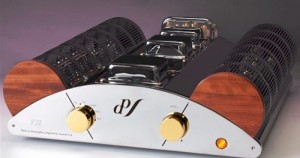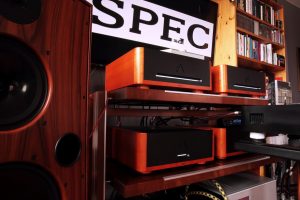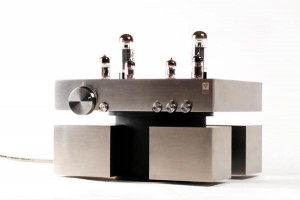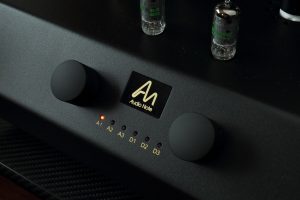SPEC Corporation is a Japanese company founded in 2010 by Mr. Shuzou Ishimi and Mr. Shirokazu Yazaki, the former chief engineer of TEAC and Pioneer and International Rectifier respectively, in order to achieve one goal: to provide tube sound from transistor amplifiers. The RSA-BW7 EX amplifier is its latest and most affordable amplifier. It works in class D.
LISTENING TO MUSIC
Using a top audio system cannot be compared to anything else. This experience can only be rivaled by the "first time" when we heard music played in a decent way—such things remain in the memory forever.
In my case, the "first" was a system heard in a music store, then located on the Krakow's Main Square, which included the NAD amplifier and KEF loudspeakers. However, I remember equally well when I first played the Kondo OnGaku tube amplifier, and then the RPA-MG1000 monoblocks, a powerful, four-box amplifier from the Japanese company SPEC. Interestingly, the latter were semiconductor devices, and additionally, working in class D (test HERE).
The company's products are the work of people who love tubes. I mean both of them, its long-time designer, Mr. Shirokazu Yazaki, and its current chief engineer, Mr. Banno Tsutomu, are great lovers of vacuum tube amplifiers (more in the article My private audio history HERE and in the Real-Sound Processor RSP-AZ9EX loudspeaker filter test HERE). And yet all their amplifiers operate in class D, so they are by definition solid-state amplifiers.
The transition from tubes to class D may seem like a radical change of perspective, maybe even a betrayal of ideals—and in many cases it is. But not for SPEC people. It was a natural progression for them. They assumed that the tube was the best way to amplify the audio signals. The problem for most people, however, is that it is... a tube. Amplifiers of this type need to be taken care of, tubes wear out and many music lovers do not want to deal with it. However, it is not enough to take a ready-made module offered by one of several specialized companies to achieve what the Japanese intended. In their devices, they used new solutions combined with techniques from the 1920s, 30s and 40s of the twentieth century.
First of all, most of its devices feature linear power supplies with R-core transformers. Secondly, the modulator, which converts a linear signal into a pulsed signal, was developed together with the Japanese branch of the American company International Rectifier. This is the IRS2052SM chip that controls a pair—per channel—of tiny, extremely linear MOS-FET transistors. And, thirdly, selected capacitors were used, including rare oil capacitors manufactured according to the old Western Electric specification by Arizona Capacitors in the power supply and in the output.
All devices from this company are marked "Designer Audio", because they reflect the views on the sound of their designers, and the devices themselves are referred to as "Real-Sound Amplifier," which emphasizes truthfulness of their sound. So let's remember that this is an original proposal, in which the beliefs of the creators of the device matter, even if they differ from the common opinions about how an amplifier should sound like and how it should not.
RSA-BW7 EX
RSA-BW7 EX is the latest amplifier from this company. It's also one of the smallest in their catalog. It is only 350 mm wide, 95 mm high and 375 mm deep, yet it offers 100 W (4 Ω). It weighs a moderate 6.7 kg, because there are no heavy heat sinks in it, and instead of a linear power supply for the entire device, we find a small power supply of this type for the volume control circuit and a switching power supply for the power amplifier.
Small size, despite beautiful workmanship, great electronic components and many years of research on the operation of class D amplifiers, combined with a high price still deter many potential buyers. It's a mistake. I believe that investing in amplifiers of this brand is a good investment and that they bring a lot of joy, and joy is a priceless thing. This is not just my opinion judging by how many professional reviewers and manufacturers around the world use them. One of them is Marcin Ostapowicz, who, when developing his JPLAY, JCAT and XACT products, uses the top SPEC amplifier, the RPA-MG1000, mentioned at the beginning.
Class D
Capacitors used in the output filter of the tested amplifier
It the amplifier contains an output stage (usually featuring MOSFET transistors), which is being alternately closed and opened, then the circuit operates in class D. By applying an appropriate filter between the output and the load, a correct, undistorted signal can be obtained, provided, however, that the keying is performed with a frequency at least twice as high as the highest frequency of the input signal and that the duty cycle of the output pulses is proportional to the instantaneous value of the audio signal. This group of amplifiers is rightly called impulse amplifiers.
source: www.EASY-SOFT.net, accessed: 12.04.2023.
Products of this company have a very balanced, very "Japanese" look. The combination of metal and wood immediately catches the eye. We haven't talked about it yet, but SPEC encloses their amp cabinets with wood. This is explained by the fact that devices operating in class D, i.e. with high switching frequencies, are very sensitive to vibrations.
And one of the best methods to suppress them is the use of wood. SPEC says that in choosing a particular material, it follows the steps of luthiers building musical instruments. Such a "package" consists of several elements—in this case three: two side walls, which also form the front feet, and a third foot at the back of the device. Each model is carefully auditioned to select the best type of wood for these elements. Metal elements are made of steel and aluminum (front).
It is an extremely minimalist amplifier—which again refers us to tube devices because it only offers volume control and input selection. And there are only four of them, all linear: three RCA and one XLR. The device is an unbalanced design, so the latter is added for the convenience of the user but not truly symmetrical. The only two LEDs indicate the status of the device—the white one means it's on and the red one means it's turned off. The power supply is turned on using a great, characteristic for this company, toggle switch with a latch, preventing accidental switching off.
In the model symbol we find the "EX" designation, which we would probably read as a clue that this is a special version. In this case, however, the point is that it is a model intended for sale outside of Japan. One of the changes compared to the "national" version is the lack of backlight for knobs—I think it's a good choice. The amplifier for the Japanese market highlights them in orange.
The RSA-BW7 EX features no remote control, at least not one as we know it. It's a conscious choice. The company's engineers believe that the receiver's control circuits are interfering with the amplification circuits. WHICH makes sense—class D amplifiers work with very high switching frequencies, of the order of several hundred kHz. Therefore, an external remote control is available, with radio signal transmission, which we connect to the amplifier using a cable with a mini-jack plug. The receiver is placed next to it—it has the form of a small box made of aluminum and wood. The control system (remote control plus receiver) is sold separately.
SOUND
HOW WE LISTENED
The SPEC RSA-BW7 EX amplifier was tested in the High Fidelity reference system and was compared to a split system consisting of the Ayon Audio Spheris III tube preamplifier and the Soulution 710 transistor power amplifier; I devoted a separate listening session to comparing it with the Leben CS-600X tube amplifier.
pct. b
The SPEC was placed on the Finite Elemente Master Reference Pagode Edition Mk II rack. It was connected to the Ayon Audio CD-35 HF SACD player using RCA Crystal Cable Absolute Dream interconnects, and to the Harbeth M40.1 speakers using Art Series Da Vinci cables from the same company. The amplifier was powered by the Harmonix X-DC350M2R Improved-Version cable. Let's add that there were also SPEC RSP-901EX loudspeaker filters in the signal's path, called by the manufacturer: Real-Sound Processor.
Recordings used for the test | a selection
Frank Sinatra, Nice'n'Easy, Capitol Records/Mobile Fidelity Sound Lab UDCD 790, "Original Master Recording" Gold CD (1960/2008), review HERE.
Benny Carter, Jazz Giant, Contemporary Records/Craft Recordings CR00500, SACD/CD (1958/2022).
Depeche Mode, Memento Mori, Columbia | Sony Music 19658784202, CD (2023).
Yo-Yo Ma, Chris Thile, Edgar Meter, Bach Trios, Nonesuch/Warner Music Japan WPCS-13681, CD (2017), review HERE.
King Crimson, In The Court Of The Crimson King (An Observation By King Crimson), Island Records/Discipline Global Mobile/WOWOW Entertainment IEZP-128, 50th Anniversary Box Set, 3 x K2HD UHQCD + Blu-ray (1969/2019).
Mayo Nakano Piano Trio, Miwaku, Briphonic BRPN-7007GL, Extreme Hard Glass CD-R (2017); more HERE.
ENYA, Enya, BBC Entertainment BBC CD 605, CD (1987); more HERE.
Saying that I didn't expect what I would hear with the RSA-BW7 EX amplifier, I would be telling a lie. It is because I have known their products for many years, I was often their first reviewer in the world, and I also got to know, as much as it was possible, Mr. Shirokazu Yazaki and Mr. Banno Tsutomu. I understand the philosophy behind these devices, I respect it and its creators, and most of all—I am an ardent supporter of looking at the musical matter they represent. This is "my" sound.
And it is an incredibly dense sound. In the sense that it is filled with information that creates not details, but a three-dimensional, deep sound. So it took just a few seconds of the opening title track of Frank Sinatra's album Nice'n'Easy to feel good, feel at home. The track in question was recorded in a separate session on March 13th and the remaining tracks over three consecutive days, from March 1st to March 3rd. It's the only song on the album that isn't a ballad. And I think it sounds a bit better than the other songs.
Anyway, Sinatra's vocals are captured in a full, dense way. The stereophony of the recording, and this is the year 1960, is typical for that period, i.e. we are dealing with a scheme: left - center - right, without the instruments being arranged in a semicircle. The band with drums and brass instruments was on the left, and the strings on the right. And yet it has a sense of coherence and fullness. On the one hand, this is the advantage of the excellent arrangement by Nelson Riddle, and on the other hand, the vigilant execution and wonderful Studio A of Capitol Records.
Did you notice? I keep writing about the album, and I haven't even started a formal analysis of the sound. And this is because the RSA-BW7 EX shows the music in a way that allows it to resonate, it does not draw our attention to details. They are there, it is quite a resolving sound. And yet we focus on the beauty of the chords, on the presentation as a whole, and we do not look for "details" in it. This is helped by excellent saturation of the lower midrange and mid-bass. So when the low-pitched trombone comes in at the beginning of the third minute of How Deep Is The Ocean, it's really low. And Sinatra's vocals are always strong and in the foreground.
It was similar with another trombone—Frank Rozzolino, recorded by Roy DuNann on Benny Carter's Jazz Giant album. Here it was placed further away, it did not have such a low extension, but this was the choice of the sound engineer, not the amplifier. DuNann recorded albums for Contemporary Records in a back room, in a warehouse, lined with record shelves, and did not have the powerful Capitol studio at his disposal. So he had no chance to record the response of the room, and it is this response that makes the sound of the instrument large and gives it proper momentum.
But also in this case I could hear something that is characteristic of SPEC amplifiers—smooth, warm treble. If you needed other evidence that its designs share DNA with tube amplifiers, you would not need to look any further. Although the solid presence of Sinatra's vocals, the beautiful extension of the trombone, and the coherence of the sound should be enough. But if not, the smoothness, beauty, resonance and fusion of the cymbals, which the tested amplifier shows—as it seems to me is something one can't argue.
All of this creates a kind of multi-dimensional, multi-layered palimpsest, a kind of thick "carpet". One walks on it comfortably and with pleasure. However, it is also a resolving device. I said earlier that it was "quite" resolving, but that's not true—it is exceptional in this respect. On I'm Coming Virginia, when Benny Carter plays the trumpet solo in the left channel, and he is playing himself, there is a slight hiss accompanying the playing itself, slightly ahead of the sound. You can hear it with many other amplifiers, but with the SPEC we know that this is part of the performance, not "dirt".
This type of presentation, combining density, smoothness of the treble and low midrange, could be associated with "old people's sound". I apologize to all senior citizens, I know it's a harmful stereotype, but maybe it will be an element that will disenchant this time in a person's life. What I mean is that the SPEC plays with a well-ordered, well-thought-out sound, which "doesn't have to" do anything, only "can." Without the pleasure-destroying vibrations, but with an internal "drive," thanks to which both Sinatra and Carter's albums, as well as Ghost Again from the Memento Mori album by the Depeche Mode duo, sounded in a dynamic way.
The stereotype cited above stems, in part, from the fact that the "young" are impatient. Thoughtful answers, no rush, a balanced look—these are the features that we start to appreciate as we get older. When we understand that it makes sense, and everything else is a waste of time, which goes against of how "youth" perceives it all. And that's how SPEC plays. It celebrates the moment, plays with silence, color, complex elements, not feigned enthusiasm. Sounds emerge with it from absolute, black silence, which further enhances the impression of fullness.
Dynamics is another aspect of this sound that is worth paying attention to. It is so that the tested amplifier has a shaped sound and shaped in a specific way. Part of it is the softening of sharpness from around 5-6kHz. This gives an interesting effect of depth, adding to the real depth. The sources on the stage in front of us are not precisely defined, i.e. they do not have clear edges. We perceive them as separate "sound events" because of their three-dimensionality, a different sound signature, and not by selectively extracting them from the mix.
So when Dave Gahan sings in the middle, quite far away on the stage—this is a characteristic feature of this group—and Martin Gore sings backing vocals, we know perfectly well that the main vocal is on the axis of the listening session, and the backing vocals are placed on the sides. But it is also not a separation that we know from devices like Hegel or even Haiku Audio. There the sound has clearer contours, it is brighter, more open and expressive, it also has a less weighted midrange. Both presentations are equally interesting, but completely different, both lead to the same goal, but through different paths.
Summary
Yo-Yo Ma, Chris Thile and Edgar Meyer met in March 2016 at the Berkshires studio, owned by the legendary in the United States musician, James Taylor, to record material for the Bach Trios album. This recording is unusual in that the role of the harpsichord was taken on by a mandolinist, the cello plays the role of the violin, and the double bass plays the role of the cello (or viola da gamba). It sounds amazing.
The SPEC RSA-BW7 EX amplifier allowed me for a long, relaxed listen to this album. Relaxed in terms of focusing on the music, not the mechanics of its reproduction. It achieved it by warming up the sound and saturating the midrange with harmonics. It offered low, dense bass, but bass without super-fine edges. Its definition was really very good, because nothing "dragged" or rumbled, and it was dense and compact. But this was a different bass from what amplifiers such as Accuphase, Hegel, etc. offer.
The device builds a very dense, deep presentation, in which there are no hyper-stereophonic effects, because our attention is focused on what is in front of us. The edges of the stage are not spread out wide, but rather thickened closer to the center. And they are thickened—the whole panorama is equally important for this device, so there is no question of thinning the sound along with the way the instruments are placed further and further away from the listening axis. The device appeals to the hearts of connoisseurs of beautiful colors and a natural soundstage. It sounds great.
DESIGN
FRONT AND REAR
SPEC's amplifier is small but very well proportioned. On the front panel, made of aluminum, there are only three manipulators: two knobs and a toggle switch. The knobs have a large diameter ϕ, which makes them easy to handle. Although the device is based on an integrated resistor array, and therefore an encoder, the volume knob has a start and end point. The power switch has a latch that prevents it from being turned off accidentally. There are two LEDs next to it—white and red. The first one indicates when the amplifier is on, the second when it is off.
On the back we will see three pairs of nice, screwed RCA sockets with gold-plated contacts and a pair of XLR sockets. Usually Swiss Neutrik sockets are used, but those in SPEC have no markings. There are gold-plated speaker terminals next to it. Next to the IEC power socket there is a link for an external remote control—a mini-jack socket.
INSIDE
The electronic circuits are assembled on three printed circuit boards—two with power supplies and one with an amplifier; the latter is shielded.
The signal from the nice, gold-plated, screwed-on input sockets runs via long Belden interconnects to the switch on the front panel, and from there returns to the amplifier board. At its input there is an integrated Cirrus Logic 3310-KSZ resistor attenuator. It is an analog resistor ladder, no longer produced, but SPEC still values it. However, there is another chip next to it, Tachyonix Corporation—and its symbol is 3310IR01. This encoder is manufactured by this Japanese company under the license of the International Rectifier, and is based on the 3310S06S model. It cooperates with the knob on the front panel and converts its position into a series of signals controlling the attenuator.
After attenuation, the signal goes to the modulator, which together with the MOSFET output transistors is placed on the bottom of the board; transistors were screwed to the bottom of the case, which acted as a heat sink. Voltage stabilizing circuits are screwed to the side of the chassis by means of an aluminum bar.
The output of the class D amplifier is a key element of the circuit—it is a reconstruction filter. It is made of coils and capacitors. These are core coils. SPEC has been experimenting with capacitors for years. Instead of one, they selects several of different built, checking the sound during listening sessions. In the tested amplifier, there are three different types of capacitors at the output of each channel, and the manufacturer says that these specific capacitors are responsible for excellent bass:
- electrolytic, by Nichicon.
- mica, manufactured for SPEC, belonging to the MC-DA series. They are made of laminates, which is supposed to reduce inductance, and the material which is the best mica of this type, "ruby mica," comes from India. The electrodes are made of sputtered silver.
- polypropylene from Vishay.
There are two power supplies in the tested amplifier. The smaller one is placed right next to the power socket and the high frequency filter and is based on a small Talema transformer. It seems to power the attenuator circuit. Its board features an oil capacitor of the American company Arizona Capacitors, modeled on the Western Electric model known from the 1960s. At the front there is the main power supply for the power amplifier. It works with a high frequency and we find, among others, Nichicon capacitors in it. The power supply is shielded.
All components are of high quality and have been selected as a result of listening tests. This means time and high costs. This is how the capacitors were selected, as well as the cabling. SPEC is faithful to the American company Belden and chooses for its projects models that are the equivalent of cables from this company from the 1940s, i.e. made of tinned copper. This is also the case with the RSA-BW7 EX model.
Technical specifications (according to the manufacturer)
- Maximum output: 100 W (4Ω)
- Frequency range: 10 Hz – 30 kHz (±1 dB, 6 Ω, 1 W)
- THD: 0.02% (1 kHz, 80% output)
- Input sensitivity: 300 mV rms
- Gain: 37.3 dB (volume MAX, 6 Ω, 1 kHz)
- Power consumption: With no signal : 18 W, during maximum output : 180 W (8 Ω, 100 Hz)
- Dimension (W x H x D): 350 × 95 × 375 mm
- Weight: 7 kg
- Price (when reviewed): 6150 EUR
SPEC-CORP
Contact: 6th Fl. Shin Kioi-Chobuilding
4-1 Kioi-Cho Chiyoda-Ku
Tokyo 102-0094 ǀ JAPAN
MADE IN JAPAN
Provided for test by: MUSON PROJECT
text WOJCIECH PACUŁA
TRANSLATION Marek Dyba
Images by High Fidelity














































